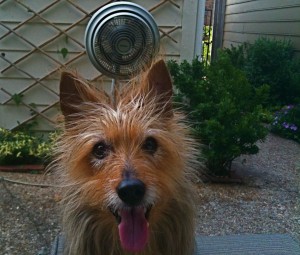I’ve met many people who did not take any special steps to introduce their pups to a crate and their pups learned to relax while crated.
Most people just place their puppy in the crate, give the pup a treat, and ignore any signs of protest. After a few days, the pup begin to relax while crated. Assuming the puppy’s physical and emotional needs are being met, this method is okay by me.
Other pups require a more thoughtful approach.
The concepts for teaching a dog to remain calm in a crate can be adapted to teach a dog to relax when alone in other areas, such as the back porch, another room in the house or briefly tethered to a piece of furniture or door knob.
Before you lock your pup inside a crate and leave the house, introduce your pup to the crate in small doses.
This is best achieved over a long weekend. I like to remove the door at first, so the pup doesn’t get spooked by the swinging door. In some instances, I might even remove the top portion (airline type crates) and present the crate without the top or door attached. It depends on the dog.
Toss some treats inside the crate and let your dog find them without any input from you.
The idea is to form an association between the crate and good things, such as surprise treats.
Feed your dog in the crate. Place water bowl in the front of the crate.
If your dog is hesitant to enter the crate, start by placing the food bowl or treats inside the front edge of the crate so that your dog can eat without entering the crate.
Once he is comfortable eating with his head inside the crate, move the bowl just a bit farther inside the crate. Gradually move the food farther back inside the crate over the next few days. Always remove the bowl with any leftover food after 10-15 minutes.
Once the dog will readily enter the crate to eat, introduce him to the concept of the crate door. Here’s how to do it. With your dog outside of the crate, attach the door and let your dog investigate it. Swing it open and latch it shut several times. Tell him “this is door”.
Naming things that interest your dog is a great method to teach your dog about the environment.
Feed him inside the crate with the door attached. After a few meals, he’ll be accustomed to the door.
Now it’s time to introduce him to the closed door when he is inside. As soon as he is happily eating, tell him, “I’m closing the door” and swing the door shut and latch it. Wait a moment and immediately open the door.
Say nothing, just watch him eat and let him come out when he’s finished.
Repeat this sequence during the next few meals, but increase the amount of time the door remains closed.
As you progress through these steps, begin to walk a few steps away. Gradually increase your distance from the crate over several sessions.
In addition to introducing your pup to the crate during meals, start crating your pup late in the evening or mid-mornings. Assumedly he will be tired and ready to rest.
For this exercise I like to place the crate near my favorite chair, in the family room or in the kitchen. This will teach your dog to relax in the crate when people are nearby. You can move the crate farther away in small increments during this introductory period.
Get a Kong®. Amazon stocks all the Kongs at great prices. If you have a puppy, get a puppy kong. They are softer and easier to compress.
Place a bit of wide, silver duct tape over the small opening to seal it off.
Place a few treats or pieces of dog food inside.
Pour some water and a bit of chicken broth inside the Kong®. Stand it upright in the freezer and let it freeze.
Remove the frozen Kong® from the freezer, remove the duct tape and give the Kong® to your crated pup. Once he is engrossed in the Kong®, tell him, “I’m closing the door” and then close the door. He’ll spend 15-25 minutes stimulating his mind and his body while he is foraging inside his crate.
If he has been well-exercised before this “Crate-Kong” sequence, he’ll probably fall asleep soon after he’s finished.
If, after several crate-Kong sessions, your pup is still anxious in the crate, ask your vet for the name of a qualified behavior counselor.
If your puppy just barks and doesn’t want the Kong®, try again later when he is hungry.
Happy Training!
Alan J Turner – Companion Animal Behavior Counselor and Trainer, Canine Specialization
How’s Bentley – Memphis, Collierville, Germantown TN
21st Century Canine Relationship Solutions
Private Dog Training in Memphis TN
Reactive Dog Specialist





